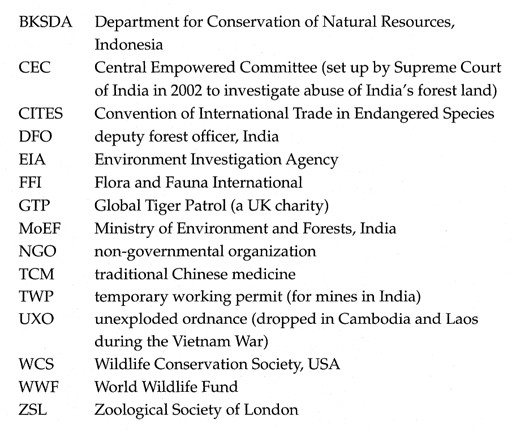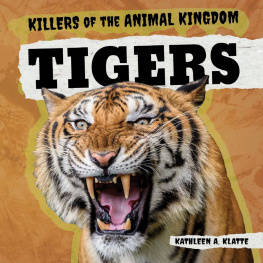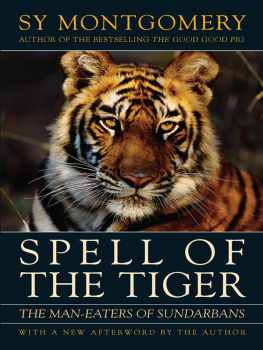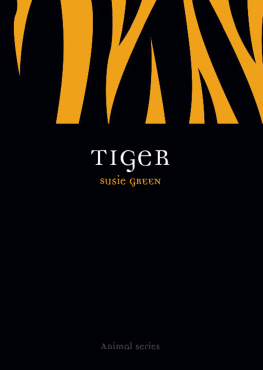TIGERS IN RED
WEATHER
For reading, listening and commenting, whether on paragraphs, chapters or whole drafts, many thanks to Volta Bone, Amanda Bright, Gwen Burnyeat, Mrinal Chatterjee, Sarah Christie, Elaine Feinstein, John Goodrich, Lavinia Greenlaw, Kerin Hope, Peter Jackson, Ullas Karanth, Tom Maddox, Debbie Martyr, Dale Miquelle, Miranda Seymour, Jo Shapcott, Valmik Thapar; to everyone at Kindlings; and, over and over again, Patrick Walsh.
For help in the field, everyone in the book; and many more. I had to keep some people out of the pages for the sake of brevity, but I am very grateful to them all, which means:
In Bangladesh: Rubaiyat Mansur of the Guide Tours, Dhaka.
In Bhutan: the Kingdom of Bhutan for its kind invitation to visit; Hishey Tshering of Bhutan Heritage Travels, Thimphu; Karma Tshering, Head of Park Management Planning and Integrated Conservation and Development Programme; Sharap Wangchuk, Tiger Programme (Nature Conservation Division); Sangay Wangchuk, Joint Director Nature Conservation Division; Tshewang Norbu, Deputy Park Ranger in Jigme Singye Wangchuck National Park; Sangai, ranger in Thrumshingla National Park; Chadho Tensin of WWF Bhutan; Karma Phuntso and his parents; Princess Kunzang Choden.
In China: Endi Zhang, Aili Kang, Bing Li and staff of the WCS, Shanghai; in Hunchun, students Liu Yu (also for magnificent interpreting) and Yue, studying ungulates (just as important as tigers themselves); the Director and staff of Hunchun Tiger Reserve, Jilin province, especially Li Zhi Xing, Director of Policy and Education; in Yihuang, the Director and staff of Yihuang Reserve, Jiangxi province; and Wang and Cao, translators from Nanchang.
In India: Amanda Bright and Carole Elliott of GTP; Anil, resident naturalist of Tuli Tiger Resort, Kanha; Mrinal Chatterjee and the crew of his boat; Raghu Chundawat, Vinnie and Anil of the Ken River Lodge, Panna; Vipul Jain, guide to Ranthambhore National Park; Lee and Stephen Emery; Ullas Karanth of WCS; all members and Trustees of Wildlife First; and the Wildcats, especially Shreedev Hulikere; Ayappa Paniker, D. V. Girish, P. K. Sen, Fateh Singh Rathore, Jaisal Singh and the staff at Sher Bagh, Ranthambhore; Valmik Thapar.
In Laos: Changsavi Vongkhamheng of WCS; Boatang in Phou Loei Biodiversity Reserve; Arlyne and Mike Johnson of WCS; and Toh, who saw me safe through the Nam Ha Bio-diversity Reserve.
In Nepal: Charles 'Chuck' McDougal; John Roberts, Field/Guest Relations Officer at Tiger Tops; all the staff, especially trackers, naturalists and mahouts, at Tiger Tops Jungle Lodge, Royal Chitwan National Park.
In Russia: Olga Bekhtereva of Dalintourist Travel, Vladivostock; Sergei Bereznuk of the Phoenix Fund; Dale Miquelle; John Goodrich and the staff of WCS Vladivostock and Terney; Michiel Hotte of the Tigris Foundation; Yevgeny and Tamara of Terney; Dr Yudin of the Russian Academy of Biological Sciences, Gaivoron village, near Khanka Nature Reserve, Primorye; Sergei Zubtsov, Head of Inspection Tiger.
In Sumatra: Tom Maddox, and everyone working for ZSL; Sean Marron and Ian Rowland of PT Asiatic Persada; Elva Gemita, Volta Bone; Debbie Martyr of FFI and all the Tiger Team members; Ibu Lystia Kusumardhani of the Indonesian Forest Service; Ramla of J. L. Sumur, Aceh Village no. 34, Lahat; Vera of PT Trijaya Travel Medan, and Lilik for interpreting and guidance under difficult circumstances; and, backstage and in absentia, Jeremy Holden.
In Thailand: Tim Redford of Wildaid; Tony Lynam of WCS.
For advice, help, and answering ignorant emails or phone calls out of the blue, Anthony Aris, Debbie Banks of EIA, Alan Blanchard of Tiger Trails, Amanda Bright of GTP, Judy Mills, Tessa McGregor, Dan Cao of the WWF Traditional Chinese Medicine Programme, Andy Fisher, Head of the Metropolitan Police Wildlife Unit at New Scotland

Among so many unfamiliar names, I have used the old Anglicized forms for place names which Western audiences in the past have generally recognized, such as Calcutta, Bombay, Rangoon, or the Irrawaddy River. Yard, the Harrison Institute; Peter Jackson, Chairman Emeritus, Cat Specialist Group, World Conservation Union (IUCN); Monirul Khan; John Lewis of the International Veterinary Group; John Keeble; Karma Phuntso; Li Quan of Save China's Tigers; Alan Rabinowitz and Linde Ostro of WCS; Frances Wood of the British Library. And two people who put me in touch with other tiger people all over the world, and were unfailingly generous with their time, advice, knowledge and judgement: Sarah Christie of ZSL and Valmik Thapar.
Thanks also to the Calouste Gulbenkian Foundation for a grant from their 'Arts and Science' programme, shared with Dr Ullas Karanth. And to those who extended invitations to give poetry readings, through which I learned about countries and people in a different way: the British Council in Mandalay, Yangon and Shanghai; Elena Vasil'eva and the Grey Horse Poetry Circle, Vladivostock; Ayappa Paniker and the Poetry Chain, Trivandrum; Dr Yusrita Yanti of Bung Hatta University, Padang; and to the Environmental Investigation Agency for permission to reproduce arrows from their map in TheTigerskin Trail.
Thanks also for information, and permission to visit the Jambi plantation, to Sean Marron, President Director of PT Asiatic Persada, and Ian Rowland, Environment Manager, PT Asiatic Persada. A few paragraphs in three chapters derive from short stories I published in Dublin Review, Prospect Magazine and Hyphen: Short Stories by Poets, edited by Ra Page (Comma and Carcanet Press, 2003). Many thanks to three editors it was a pleasure to work with. Finally, to my agent and friend Patrick Walsh, creative, merciless and patient critic; my beloved editor Antonia Hodgson, intuitive, generous, always supportive however far away; to Stephen Guise, for work on an intricately messy manuscript; Vanessa Neuling of Time Warner; to Myles Burnyeat for help, translation and support in Russia; and to Gwen, as always, for comments, criticism, excellent judgement and constant support.
This does not represent the entire geographical area of India, nor all of her tiger reserves and national parks
CONTENTS
'Tiger Drinking at Forest Pool'
Water, moonlight, danger, dream.
Bronze urn, angled on a tree-root: one
Slash of light, then gone. A red moon
Seen through clouds, or almost seen.
Treasure found but lost, flirting between
The worlds of lost and found. An unjust law
Repealed, a wish come true, a lifelong
Sadness healed. Haven, in the mind,
To anyone hurt by littleness. A prayer,
For the moment, saved; treachery forgiven.
Flame of the crackle-glaze tangle, amber
Reflected in grey milk-jade. An old song
Remembered, long debt paid.
A painting on silk, which may fade.
For my mother, who taught us to look
at animals and plants
Copyright 2006 Ruth Padel
All rights reserved. No part of this book may be reproduced in any manner whatsoever without written permission from the publisher except in the case of brief quotations embodied in critical articles or reviews. For information address Walker & Company, 104 Fifth Avenue, New York, New York 10011.
Tiger Drinking from Forest Pool7 from The Soho Leopard by Ruth Padel: reprinted by permission of The Random House Group Ltd. Erat Hora7 from Collected Poems by Ezra Pound and 'Disillusionment of Ten O'Clock7 from Collected Poems by Wallace Stevens: reprinted by permission of Faber and Faber. 'What He Said7 by Cempulappeyanirar from
Next page











